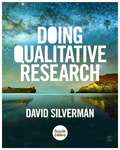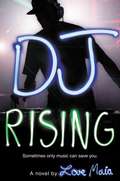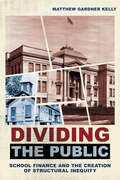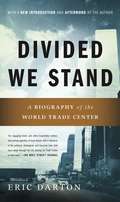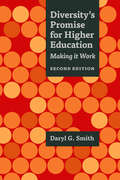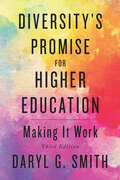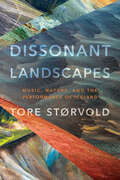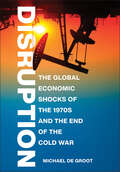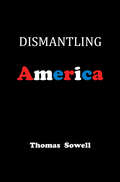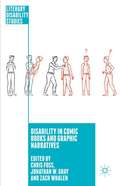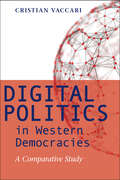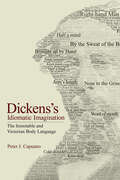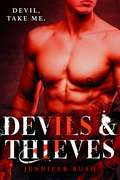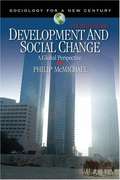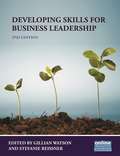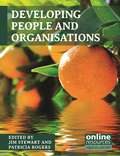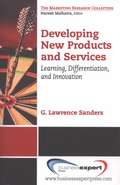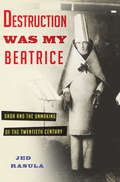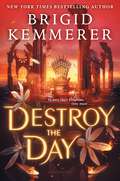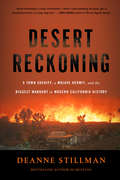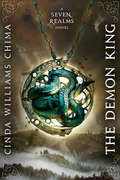- Table View
- List View
Doing Qualitative Research: A Practical Handbook (4th ediction) (PDF)
by Professor David SilvermanIn the fourth edition of his best-selling textbook, David Silverman provides a step-by-step guide to planning and conducting qualitative research. Using real examples from real postgraduate students, the book makes it easy to link theory to methods and shows how to move from understanding the principles of qualitative research to doing it yourself. The new edition has been fully updated and now includes: - a brand new chapter on formulating a research question appropriate for qualitative research - an expanded discussion of the role of theory in research - extended discussion of case study research and the number of cases needed for effective qualitative research - further coverage of focus groups and analysing internet data - new student examples from around the world - a new section on the common pitfalls encountered in qualitative research - an expanded companion website with more student examples and videos. Filled with exercises to test your understanding and develop your skills, as well as David's own tips for research success based on years of experience, this book is essential reading for anyone doing qualitative research. Available with Perusall--an eBook that makes it easier to prepare for class Perusall is an award-winning eBook platform featuring social annotation tools that allow students and instructors to collaboratively mark up and discuss their SAGE textbook. Backed by research and supported by technological innovations developed at Harvard University, this process of learning through collaborative annotation keeps your students engaged and makes teaching easier and more effective. Learn more.
DJ Rising
by Love MaiaThe first thing I hear is music. The first thing I've always heard is music.Meet Marley, an unassuming high school junior who breathes in music like oxygen. In between caring for his heroin-addicted mother, and keeping his scholarship at a fancy prep school, he dreams of becoming a professional DJ.When chance lands Marley his first real DJ job, his career as "DJ Ice" suddenly skyrockets. But when heart-rending disaster at home brings Marley crashing back down to earth, he is torn between obligation and following his dreams.
Dividing the Public: School Finance and the Creation of Structural Inequity (Histories of American Education)
by Matthew Gardner KellyIn Dividing the Public, Matthew Gardner Kelly takes aim at the racial and economic disparities that characterize public education funding in the United States. With California as his focus, Kelly illustrates that the use of local taxes to fund public education was never an inadvertent or de facto product of past practices, but an intentional decision adopted in place of well-known alternatives during the Progressive Era, against past precedent and principle in several states.From efforts to convert expropriated Indigenous and Mexican land into common school funding in the 1850s, to reforms that directed state aid to expanding white suburbs during the years surrounding World War II, Dividing the Public traces, in intricate detail, how a host of policies connected to school funding have divided California by race and class over time. In bringing into view the neglected and poorly understood history of policymaking connected to school finance, Kelly offers a new story about the role public education played in shaping the racially segregated, economically divided, and politically fragmented world of the post-1945 metropolis.
Divided We Stand: A Biography Of New York's World Trade Center
by Eric DartonWhen the World Trade Towers in New York City were erected at the Hudson's edge, they led the way to a real estate boom that was truly astonishing. Divided We Stand reveals the coming together and eruption of four volatile elements: super-tall buildings, financial speculation, globalization, and terrorism. The Trade Center serves as a potent symbol of the disastrous consequences of undemocratic planning and development.This book is a history of that skyscraping ambition and the impact it had on New York and international life. It is a portrait of a building complex that lives at the convergence point of social and economic realities central not only to New York City but to all industrial cities and suburbs. A meticulously researched historical account based on primary documents, Divided We Stand is a contemporary indictment of the prevailing urban order in the spirit of Jane Jacobs's mid-century classic The Death and Life of Great American Cities.
Diversity's Promise for Higher Education: Making It Work
by Daryl G. SmithDaryl G. Smith has devoted her career to studying and fostering diversity in higher education. She has witnessed and encouraged the evolution of diversity from an issue addressed sporadically on college campuses to a reality of the modern university experience. In Diversity’s Promise for Higher Education, Smith brings together scholarly and field research relevant to the next generation of diversity work. The book argues that achieving excellence in a diverse society requires increasing the institutional capacity for diversity while simultaneously working to understand how diversity is tied to better leadership, positive change, research in virtually every field, student success, accountability, and more equitable hiring practices. To become more relevant to society, the nation, and the world while remaining true to their core missions, colleges and universities must continue to see diversityâ€�like technologyâ€�as central, not parallel, to their work. In Diversity’s Promise for Higher Education, Smith proposes a set of clear and realistic practices that will help colleges and universities locate diversity as a strategic imperative and pursue diversity efforts that are inclusive of the variedâ€�and growingâ€�issues apparent on campuses without losing focus on the critical unfinished business of the past.In this edition, which is aimed at administrators, faculty, researchers, and students of higher education, Smith emphasizes a transdisciplinary approach to the topic of diversity, drawing on an updated list of sources from a wealth of literatures and fields. The tables have been refreshed to include data on faculty diversity over a twenty-year period and the book includes new information about gender identity, stereotype threat, student success, the growing role of chief diversity officers, the international emergence of diversity issues, faculty hiring, and implicit bias.
Diversity's Promise for Higher Education: Making It Work
by Daryl G. SmithDaryl G. Smith has devoted her career to studying and fostering diversity in higher education. She has witnessed and encouraged the evolution of diversity from an issue addressed sporadically on college campuses to a reality of the modern university experience. In Diversity’s Promise for Higher Education, Smith brings together scholarly and field research relevant to the next generation of diversity work. The book argues that achieving excellence in a diverse society requires increasing the institutional capacity for diversity while simultaneously working to understand how diversity is tied to better leadership, positive change, research in virtually every field, student success, accountability, and more equitable hiring practices. To become more relevant to society, the nation, and the world while remaining true to their core missions, colleges and universities must continue to see diversityâ€�like technologyâ€�as central, not parallel, to their work. In Diversity’s Promise for Higher Education, Smith proposes a set of clear and realistic practices that will help colleges and universities locate diversity as a strategic imperative and pursue diversity efforts that are inclusive of the variedâ€�and growingâ€�issues apparent on campuses without losing focus on the critical unfinished business of the past.In this edition, which is aimed at administrators, faculty, researchers, and students of higher education, Smith emphasizes a transdisciplinary approach to the topic of diversity, drawing on an updated list of sources from a wealth of literatures and fields. The tables have been refreshed to include data on faculty diversity over a twenty-year period and the book includes new information about gender identity, stereotype threat, student success, the growing role of chief diversity officers, the international emergence of diversity issues, faculty hiring, and implicit bias.
Diversity's Promise for Higher Education: Making It Work
by Daryl G. SmithDaryl G. Smith has devoted her career to studying and fostering diversity in higher education. In Diversity's Promise for Higher Education, Smith brings together research from a wide variety of fields to propose a set of clear and realistic practices that will help colleges and universities locate diversity as a strategic imperative and pursue diversity efforts that are inclusive of the varied—and growing—issues apparent on campuses without losing focus on the critical unfinished business of the past.To become more relevant to society, the nation, and the world, while remaining true to their core missions, colleges and universities must continue to see diversity—like technology—as central, not parallel, to their work. Indeed, looking at the relatively slow progress for change in many areas, Smith suggests that seeing diversity as an imperative for an institution's individual mission, and not just as a value, is the necessary lever for real institutional change. Furthermore, achieving excellence in a diverse society requires increasing institutional capacity for diversity—working to understand how diversity is tied to better leadership, positive change, research in virtually every field, student success, accountability, and more equitable hiring practices. In this edition, which is aimed at administrators, faculty, researchers, and students of higher education, Smith emphasizes a transdisciplinary approach to the topic of diversity, drawing on an updated list of sources from a wealth of literatures and fields. The tables and figures have been refreshed to include data on faculty diversity over a twenty-year period, and the book includes new information about • gender identity,• embedded bias,• student success,• the growing role of chief diversity officers,• the international emergence of diversity issues,• faculty hiring,• and important metrics for monitoring progress.Drawing on forty years of diversity studies, this third edition also • includes more examples of how diversity is core to institutional excellence, academic achievement, and leadership development;• updates issues of language;• examines the current climate of race-based campus protest;• addresses the complexity of identity—and explains how to attend to the growing kinds of identities relevant to diversity, equity, and inclusion while not overshadowing the unfinished business of race, class, and gender.
Diversity's Promise for Higher Education: Making It Work
by Daryl G. SmithDaryl G. Smith has devoted her career to studying and fostering diversity in higher education. In Diversity's Promise for Higher Education, Smith brings together research from a wide variety of fields to propose a set of clear and realistic practices that will help colleges and universities locate diversity as a strategic imperative and pursue diversity efforts that are inclusive of the varied—and growing—issues apparent on campuses without losing focus on the critical unfinished business of the past.To become more relevant to society, the nation, and the world, while remaining true to their core missions, colleges and universities must continue to see diversity—like technology—as central, not parallel, to their work. Indeed, looking at the relatively slow progress for change in many areas, Smith suggests that seeing diversity as an imperative for an institution's individual mission, and not just as a value, is the necessary lever for real institutional change. Furthermore, achieving excellence in a diverse society requires increasing institutional capacity for diversity—working to understand how diversity is tied to better leadership, positive change, research in virtually every field, student success, accountability, and more equitable hiring practices. In this edition, which is aimed at administrators, faculty, researchers, and students of higher education, Smith emphasizes a transdisciplinary approach to the topic of diversity, drawing on an updated list of sources from a wealth of literatures and fields. The tables and figures have been refreshed to include data on faculty diversity over a twenty-year period, and the book includes new information about • gender identity,• embedded bias,• student success,• the growing role of chief diversity officers,• the international emergence of diversity issues,• faculty hiring,• and important metrics for monitoring progress.Drawing on forty years of diversity studies, this third edition also • includes more examples of how diversity is core to institutional excellence, academic achievement, and leadership development;• updates issues of language;• examines the current climate of race-based campus protest;• addresses the complexity of identity—and explains how to attend to the growing kinds of identities relevant to diversity, equity, and inclusion while not overshadowing the unfinished business of race, class, and gender.
Dissonant Landscapes: Music, Nature, and the Performance of Iceland (Music / Culture)
by Tore StørvoldDuring the past three decades, Iceland has attained a strong presence in the world through its musical culture, with images of the nation being packaged and shipped out in melodies, harmonies, and rhythms. What 'Iceland' means for people, both at home and abroad, is conditioned by music and its ability to animate notions of nature and nationality. In six chapters that range from discussions of indie rock ballads to 'Nordic noir' television music, Dissonant Landscapes describes the capacity of musical expression to transform ideas about nature and nationality on the northern edges of Europe.
Disruption: The Global Economic Shocks of the 1970s and the End of the Cold War
by Michael De GrootIn Disruption, Michael De Groot argues that the global economic upheaval of the 1970s was decisive in ending the Cold War. Both the West and the Soviet bloc struggled with the slowdown of economic growth; chaos in the international monetary system; inflation; shocks in the commodities markets; and the emergence of offshore financial markets. The superpowers had previously disseminated resources to their allies to enhance their own national security, but the disappearance of postwar conditions during the 1970s forced Washington and Moscow to choose between promoting their own economic interests and supporting their partners in Europe and Asia. De Groot shows that new unexpected macroeconomic imbalances in global capitalism sustained the West during the following decade. Rather than a creditor nation and net exporter, as it had been during the postwar period, the United States became a net importer of capital and goods during the 1980s that helped fund public spending, stimulated economic activity, and lubricated the private sector. The United States could now live beyond its means and continue waging the Cold War, and its allies benefited from access to the booming US market and the strengthened US military umbrella. As Disruption demonstrates, a new symbiotic economic architecture powered the West, but the Eastern European regimes increasingly became a burden to the Soviet Union. They were drowning in debt, and the Kremlin no longer had the resources to rescue them.
Dismantling America: and other controversial essays
by Thomas SowellThese wide-ranging essays—on many individual political, economic, cultural and legal issues—have as a recurring, underlying theme the decline of the values and institutions that have sustained and advanced American society for more than two centuries. This decline has been more than an erosion. It has, in many cases, been a deliberate dismantling of American values and institutions by people convinced that their superior wisdom and virtue must over-ride both the traditions of the country and the will of the people.Whether these essays (originally published as syndicated newspaper columns) are individually about financial bailouts, illegal immigrants, gay marriage, national security, or the Duke University rape case, the underlying concern is about what these very different kinds of things say about the general direction of American society.This larger and longer-lasting question is whether the particular issues discussed reflect a degeneration or dismantling of the America that we once knew and expected to pass on to our children and grandchildren. There are people determined that this country's values, history, laws, traditions and role in the world are fundamentally wrong and must be changed. Such people will not stop dismantling America unless they get stopped—and the next election may be the last time to stop them, before they take the country beyond the point of no return.
Disability In Comic Books And Graphic Narratives (PDF)
by Chris Foss Jonathan W. Gray Zach WhalenAs there has yet to be any substantial scrutiny of the complex confluences a more sustained dialogue between disability studies and comics studies might suggest, Disability in Comic Books and Graphic Narratives aims through its broad range of approaches and focus points to explore this exciting subject in productive and provocative ways. Alternate ISBNs 9781349698981 9781137501110
Digital Politics in Western Democracies: A Comparative Study
by Cristian VaccariDigital politics is shorthand for how internet technologies have fueled the complex interactions between political actors and their constituents. Cristian Vaccari analyzes the presentation and consumption of online politics in seven advanced Western democracies—Australia, France, Germany, Italy, Spain, the United Kingdom, and the United States—from 2006 to 2010. His study not only refutes claims that the web creates homogenized American-style politics and political interaction but also empirically reveals how a nation’s unique constraints and opportunities create digital responses. Digital Politics in Western Democracies is the first large-scale comparative treatment of both the supply and the demand sides of digital politics among different countries and national political actors. It is divided into four parts: theoretical challenges and research methodology; how parties and candidates structure their websites (supply); how citizens use the websites to access campaign information (demand); and how the research results tie back to inequalities, engagement, and competition in digital politics. Because a key aspect of any political system is how its actors and citizens communicate, this book will be invaluable for scholars, students, and practitioners interested in political communication, party competition, party organization, and the study of the contemporary media landscape writ large.
Digital Politics in Western Democracies: A Comparative Study
by Cristian VaccariDigital politics is shorthand for how internet technologies have fueled the complex interactions between political actors and their constituents. Cristian Vaccari analyzes the presentation and consumption of online politics in seven advanced Western democracies—Australia, France, Germany, Italy, Spain, the United Kingdom, and the United States—from 2006 to 2010. His study not only refutes claims that the web creates homogenized American-style politics and political interaction but also empirically reveals how a nation’s unique constraints and opportunities create digital responses. Digital Politics in Western Democracies is the first large-scale comparative treatment of both the supply and the demand sides of digital politics among different countries and national political actors. It is divided into four parts: theoretical challenges and research methodology; how parties and candidates structure their websites (supply); how citizens use the websites to access campaign information (demand); and how the research results tie back to inequalities, engagement, and competition in digital politics. Because a key aspect of any political system is how its actors and citizens communicate, this book will be invaluable for scholars, students, and practitioners interested in political communication, party competition, party organization, and the study of the contemporary media landscape writ large.
Dickens's Idiomatic Imagination: The Inimitable and Victorian Body Language
by Peter J. CapuanoDickens's Idiomatic Imagination offers an original analysis of how Charles Dickens's use of "low" and "slangular" (his neologism) language allowed him to express and develop his most sophisticated ideas. Using a hybrid of digital (distant) and analogue (close) reading methodologies, Peter J. Capuano considers Dickens's use of bodily idioms—"right-hand man," "shoulder to the wheel," "nose to the grindstone"—against the broader lexical backdrop of the nineteenth century. Dickens was famously drawn to the vernacular language of London's streets, but this book is the first to call attention to how he employed phrases that embody actions, ideas, and social relations for specific narrative and thematic purposes. Focusing on the mid- to late career novels Dombey and Son, David Copperfield, Bleak House, Great Expectations, and Our Mutual Friend, Capuano demonstrates how Dickens came to relish using common idioms in uncommon ways and the possibilities they opened up for artistic expression. Dickens's Idiomatic Imagination establishes a unique framework within the social history of language alteration in nineteenth-century Britain for rethinking Dickens's literary trajectory and its impact on the vocabularies of generations of novelists, critics, and speakers of English.
Devils & Thieves (Devils & Thieves #1)
by Jennifer RushDevil, take me. A bewitchingly sexy urban fantasy filled with magic and motorcycles from Jennifer Rush, author of the Altered saga. In the world of the "kindled," Crowe is as close as it gets to being king. Unforgivably gorgeous and in possession of dangerous magic, Crowe is the leader of the Devils' League, a kindled motorcycle gang once headed by his father. Now desperate for answers about his father's mysterious death, Crowe is too preoccupied to resist the pull of Jemmie Carmichael, the only girl who's ever been able to see through his tough-guy persona. But Jemmie has her own problems. The only kindled who can't cast a simple spell without falling apart, she has to prove her own worth every day, and she doesn't have time to worry about Crowe's troubles--especially when she's just moved on from the last time he broke her heart...right into the arms of rival gang prospect Darek. Then the annual kindled festival comes to town, and the powder keg of tension surrounding Jemmie and Crowe explodes. Someone at the festival is practicing forbidden magic, and soon the people closest to Jemmie and Crowe begin to disappear, one by one. With no one else to trust, they'll have to lean on each other to save the people they love most, even if that means confronting everything unspoken between them.Come on a ride that will leave you breathless.
Development and Social Change: A Global Perspective (PDF)
by Philip McmichaelSituating development as a world-historical project, this text traces its contours across three historical periods: colonialism, the development era, and the era of globalization. McMichael shows how the social transformations from colonial subjects, through national citizens, to global consumers have been inspired and managed through successive projects of development, ordering a changing and unequal world. This fourth edition accentuates ecological themes, the gendering of development, and alternative development visions. Updating showcases the paradox of the development lifestyle, ecological footprints, the war on poverty, social reproduction issues, the planet of slums phenomenon, outsourcing, African re-colonization, the Latin rebellion against neo-liberalism, the rise of China and India, and the ever-changing policy face of the development establishment as it seeks to retain or renew its legitimacy at a time when development is perhaps facing its greatest challenge in the ecologically, socially, and politically destabilizing impacts of climate change.
Developing Skills for Business Leadership
by Gillian Watson Stefanie ReissnerWritten for the CIPD module, Developing Skills for Business Leadership, this text is also ideal for postgraduate business students taking a module in professional development, career development or management skills.
Developing People and Organisations
by Patricia Rogers Jim StewartOne of three books developed to cover the entire intermediate level CIPD qualification. This title focuses on optional HRM units. The other titles consist of Studying Human Resource Management and Managing People and Organisations.
Developing New Products and Services
by G. Lawrence SandersThe focus of the book is on the up-front activities and ideas for new product and service development. A central theme of this book is that there is, or should be, a constant struggle going on in every organization, business, and system between delivering feature-rich versions of products and services using extravagant engineering and delivering low-cost versions of products and services using frugal engineering. Delivering innovative products is accomplished by an endless cycle of business planning, creative and innovative insight, and learning-about and learning-by-doing activities. A number of powerful concepts and tools are presented in the book to facilitate new product development. For example, three templates are presented that facilitate new product and service development. The FAD (features, attributes, and design) template is used to identify the features and attributes that can be used for product and service differentiation. The Ten-Ten planning process contains two templates: an Organizational and Industry Analysis template and the Business Plan Overview template. These two templates coupled with the FAD template can be used to develop a full-blown business plan. Entrepreneurship, technology and product life cycles, product and service versioning, product line optimization, creativity, lock-in real options, business valuation, and project management topics are also covered.
Destruction Was My Beatrice: Dada and the Unmaking of the Twentieth Century
by Jed RasulaIn 1916, as World War I raged around them, a group of bohemians gathered at a small nightclub in Zurich, Switzerland for a series of bizarre performances. Three readers simultaneously recited a poem in three languages; a monocle-wearing teenager performed a spell from New Zealand; another young man flung bits of papier-mâché into the air and glued them into place where they landed. One of these artists called the sessions "both buffoonery and a requiem mass.” Soon they would be known by a more evocative name: Dada.In Destruction Was My Beatrice, modernist scholar Jed Rasula presents the first narrative history of the emergence, decline, and legacy of Dada, showing how this strange artistic phenomenon spread across Europe and then the world in the wake of the Great War, fundamentally reshaping modern culture in ways we’re still struggling to understand today.
Destruction Was My Beatrice: Dada and the Unmaking of the Twentieth Century
by Jed RasulaIn 1916, as World War I raged around them, a group of bohemians gathered at a small nightclub in Zurich, Switzerland for a series of bizarre performances. Three readers simultaneously recited a poem in three languages; a monocle-wearing teenager performed a spell from New Zealand; another young man flung bits of papier-mâché into the air and glued them into place where they landed. One of these artists called the sessions "both buffoonery and a requiem mass.” Soon they would be known by a more evocative name: Dada.In Destruction Was My Beatrice, modernist scholar Jed Rasula presents the first narrative history of the emergence, decline, and legacy of Dada, showing how this strange artistic phenomenon spread across Europe and then the world in the wake of the Great War, fundamentally reshaping modern culture in ways we’re still struggling to understand today.
Destroy the Day (Defy the Night #3)
by Brigid KemmererIn the thrilling conclusion to the Defy the Night series, New York Times bestselling author Brigid Kemmerer crafts heartrending twists and devastating turns that will keep readers breathless to the very end.Left for dead, but desperate to survive . . . they have one last chance to save their kingdom. Prince Corrick is out of options. Held captive by the vicious Oren Crane, he's desperate to reunite with Tessa, but will need to ally with the rebel leader Lochlan, who until now wished him dead. An unlikely but deadly pair, Corrick and Lochlan must plot their next moves carefully. . . An island away, Tessa Cade is heartbroken and angry. Grieving Corrick, and unsure how to find a way back to Kandala, she doesn't know who to trust. Until Rian--the man she trusts least--makes an offer: aid in a plot to finally oust Oren Crane and see what the future holds. . . Meanwhile in Kandala, Harristan is dethroned and on the run. He's struggling to unite the rebels in his fractured kingdom, but he finds support--and maybe more--in unexpected places.Can Harristan be the king his people need? Can Corrick and Tessa find their way back to each other? As outside threats loom and the fires of revolution burn from within, time is running out to save their kingdom.
Desert Reckoning: A Town Sheriff, a Mojave Hermit, and the Biggest Manhunt in Modern California History
by Deanne StillmanNorth of Los Angeles - the studios, the beaches, Rodeo Drive - lies a sparsely populated region that comprises fully one half of Los Angeles County. Sprawling across 2200 miles, this shadow side of Los Angeles is in the high Mojave Desert. Known as the Antelope Valley, it's a terrain of savage dignity, a vast amphitheatre of startling wonders that put on a show as the megalopolis burrows northward into the region's last frontier. Ranchers, cowboys, dreamers, dropouts, bikers, hikers, and felons have settled here - those who have chosen solitude over the trappings of contemporary life or simply have nowhere else to go. But in recent years their lives have been encroached upon by the creeping spread of subdivisions, funded by the once easy money of subprime America. McMansions - many empty now - gradually replaced Joshua trees; the desert - America's escape hatch - began to vanish as it became home to a latter-day exodus of pilgrims.It is against the backdrop of these two competing visions of land and space that Donald Kueck - a desert hermit who loved animals and hated civilization - took his last stand, gunning down beloved deputy sheriff Steven Sorensen when he approached his trailer at high noon on a scorching summer day. As the sound of rifle fire echoed across the Mojave, Kueck took off into the desert he knew so well, kicking off the biggest manhunt in modern California history until he was finally killed in a Wagnerian firestorm under a full moon as nuns at a nearby convent watched and prayed.This manhunt was the subject of a widely praised article by Deanne Stillman, first published in Rolling Stone, a finalist for a PEN Center USA journalism award, and included in the anthology Best American Crime Writing 2006. In Desert Reckoning she continues her desert beat and uses Kueck's story as a point of departure to further explore our relationship to place and the wars that are playing out on our homeland. In addition, Stillman also delves into the hidden history of Los Angeles County, and traces the paths of two men on a collision course that could only end in the modern Wild West. Why did a brilliant, self-taught rocket scientist who just wanted to be left alone go off the rails when a cop showed up? What role did the California prison system play in this drama? What happens to people when the American dream is stripped away? And what is it like for the men who are sworn to protect and serve?
The Demon King (Seven Realms #1)
by Cinda Williams ChimaNew York Times' best-selling author Cinda Williams Chima (The Dragon Heir), presents the first installment in a thrilling new fantasy series. Chima's phenomenal sales success is bound to continue with The Demon King!
